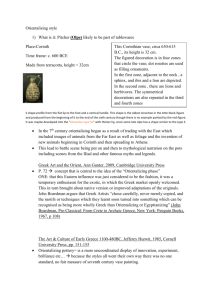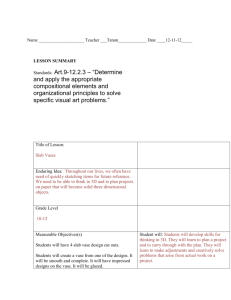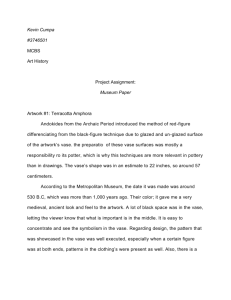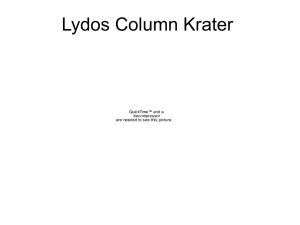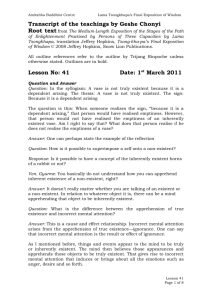Volumes of Solids of Revolution12
advertisement
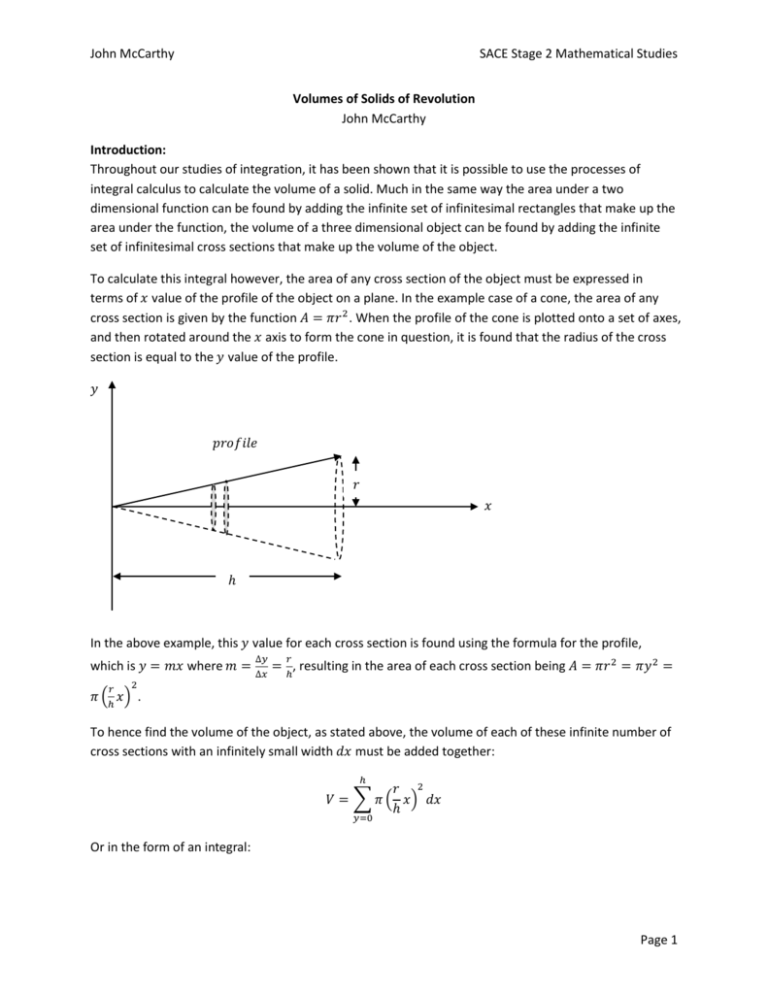
John McCarthy SACE Stage 2 Mathematical Studies Volumes of Solids of Revolution John McCarthy Introduction: Throughout our studies of integration, it has been shown that it is possible to use the processes of integral calculus to calculate the volume of a solid. Much in the same way the area under a two dimensional function can be found by adding the infinite set of infinitesimal rectangles that make up the area under the function, the volume of a three dimensional object can be found by adding the infinite set of infinitesimal cross sections that make up the volume of the object. To calculate this integral however, the area of any cross section of the object must be expressed in terms of 𝑥 value of the profile of the object on a plane. In the example case of a cone, the area of any cross section is given by the function 𝐴 = 𝜋𝑟 2 . When the profile of the cone is plotted onto a set of axes, and then rotated around the 𝑥 axis to form the cone in question, it is found that the radius of the cross section is equal to the 𝑦 value of the profile. 𝑦 𝑝𝑟𝑜𝑓𝑖𝑙𝑒 𝑟 𝑥 ℎ In the above example, this 𝑦 value for each cross section is found using the formula for the profile, ∆𝑦 𝑟 which is 𝑦 = 𝑚𝑥 where 𝑚 = ∆𝑥 = ℎ, resulting in the area of each cross section being 𝐴 = 𝜋𝑟 2 = 𝜋𝑦 2 = 𝑟 2 𝜋 (ℎ 𝑥) . To hence find the volume of the object, as stated above, the volume of each of these infinite number of cross sections with an infinitely small width 𝑑𝑥 must be added together: ℎ 𝑟 2 𝑉 = ∑ 𝜋 ( 𝑥) 𝑑𝑥 ℎ 𝑦=0 Or in the form of an integral: Page 1 John McCarthy SACE Stage 2 Mathematical Studies ℎ 𝑟 2 𝑉 = ∫ 𝜋 ( 𝑥) 𝑑𝑥 ℎ 0 For example, in the case of a 4cm tall cone with a base radius of 2cm, the volume would be given by 𝑉 = 4 2 2 ∫0 𝜋 (4 𝑥) 𝑑𝑥 = 1 𝜋 3 16 𝜋 3 1 cm3. Using the already known formula for the volume of a cone, 𝑉 = 3 𝜋𝑟 2 ℎ = × 22 × 4, we get the same result of 16 𝜋 3 cm3 . In general, this process demonstrates the relationship that the volume of any solid when rotated around 𝑏 the 𝑥 axis is given by 𝑉 = ∫𝑎 𝐴(𝑥) 𝑑𝑥 , where 𝑎 and 𝑏 are the starting and ending points of the object on the profile function and 𝐴(𝑥) is the area. Calculating the volume of a vase: In this investigation, the processes described above in conjunction with mathematical modeling were used to estimate the volume of a vase with a circular cross section. The vase in question Page 2 John McCarthy SACE Stage 2 Mathematical Studies The vase in question was laid on a piece of A4 lined grid paper with the 𝑥 axis aligned with the center of the vase. A pencil was then used to trace the profile of the vase onto the paper, and using a ruler as well as the grid provided, the values of the radius of the cross section at regular intervals along the profile were recorded to an accuracy of 1 mm. Position along 𝒙 axis (cm) 0 0.5 1 2 3 4 5 6 7 8 9 10 11 12 13 14 15 16 17 18 19 20 21 22 Radius of cross section (cm ±𝟏mm) 2.5 3.5 3.7 3.9 4.1 4.3 4.5 4.6 4.7 4.9 5 5.1 5.2 5.3 5.4 5.4 5.2 5 4.5 4 3.7 3.7 4 4.8 6 5 4 Radius of 3 cross section y = 4E-07x6 + 1E-05x5 - 0.0014x4 + 0.0293x3 - 0.2494x2 + 1.0195x + 2.7527 2 1 0 0 5 10 15 20 25 Position along x axis Page 3 John McCarthy SACE Stage 2 Mathematical Studies As seen in the graph above, due to the irregular nature of the profile of the vase, a single line of best fit was unable to pass inside all the error bars, and hence could not be taken as an accurate model of the profile of the vase. As such, the vase was separated into three component parts to allow for a model to be accurately produced: Model of the profile of the vase 6 y = 2x + 2.5 y = 0.01389x3 - 0.65357x2 + 9.61825x - 38.3667 5 4 First component Radius of 3 cross section Second component Third component 2 y = -0.0000156x5 + 0.0005014x4 - 0.00549x3 + 0.01734x2 + 0.19252x + 3.48928 1 0 0 5 10 15 20 25 Position along x axis As seen in this new model, three models, one linear, and two polynomials, were used to model separate components of the profile. Each of these three components now pass through the error bars of each point of ±1mm and smoothly join up to each other to accurately represent the profile of the vase. To find the total volume of the vase, the volumes of the three solids that result from the rotation of the three models around the 𝑥 axis must be added together. To find where each of these three models start and end, the intersections between each line of best fit must be found. Page 4 John McCarthy SACE Stage 2 Mathematical Studies The intersection between the first and second components occurs when 2𝑥 + 2.5 = −0.0000156𝑥 5 + 0.0005014𝑥 4 − 0.00549𝑥 3 + 0.01734𝑥 2 + 0.19252𝑥 + 3.48928 −0.0000156𝑥 5 + 0.0005014𝑥 4 − 0.00549𝑥 3 + 0.01734𝑥 2 + −1.80748𝑥 + 0.98928 = 0 𝑥 = 0.550 The intersection between the second and third components occurs when −0.0000156𝑥 5 + 0.0005014𝑥 4 − 0.00549𝑥 3 + 0.01734𝑥 2 + 0.19252𝑥 + 3.48928 = 0.01389𝑥 3 − 0.65357𝑥 2 + 9.61825𝑥 − 38.3667 −0.0000156𝑥 5 + 0.0005014𝑥 4 − 0.01938𝑥 3 + 0.67091𝑥 2 − 9.42573𝑥 + 41.856 = 0 𝑥 = 8.67395, 16.3896, 17.2046 Between the second and third components we have three intersection points. The first point 𝑥 = 8.67395 is not part of the model, however the second and third points represent where the two functions have overlapped slightly. As such, the average of the two points 16.3896+17.2046 2 = 16.7971 will be used. The final point, where the third component of the profile ends, is at the point 𝑥 = 22.5 where the original plot of the vase ended. Knowing these intersection points, the volumes of the three components can hence be calculated to give the total volume of the vase. To calculate the volumes using the equation found earlier, 𝑉 = 𝑏 ∫𝑎 𝐴(𝑥) 𝑑𝑥, we must know the area of cross sections of each component, 𝐴(𝑥). For a circle, the area is given by the expression 𝐴 = 𝜋𝑟 2 but it was shown earlier that the radius is given by the 𝑦 value of the profile, or 𝐴 = 𝜋𝑦 2 . Using this knowledge, we can hence calculate the total volume of the vase by adding the volumes of each of the three components: 0.550 𝑉=∫ 𝜋(2𝑥 + 2.5)2 𝑑𝑥 0 16.7971 𝜋(−0.0000156𝑥 5 + 0.0005014𝑥 4 − 0.00549𝑥 3 + 0.01734𝑥 2 +∫ 0.550 + 0.19252𝑥 + 3.48928)2 𝑑𝑥 22.5 +∫ 𝜋(0.01389𝑥 3 − 0.65357𝑥 2 + 9.61825𝑥 − 38.3667)2 𝑑𝑥 16.7971 When evaluated, 𝑉 is found to be 1501.74 𝑐𝑚3 . Page 5 John McCarthy SACE Stage 2 Mathematical Studies Page 6

